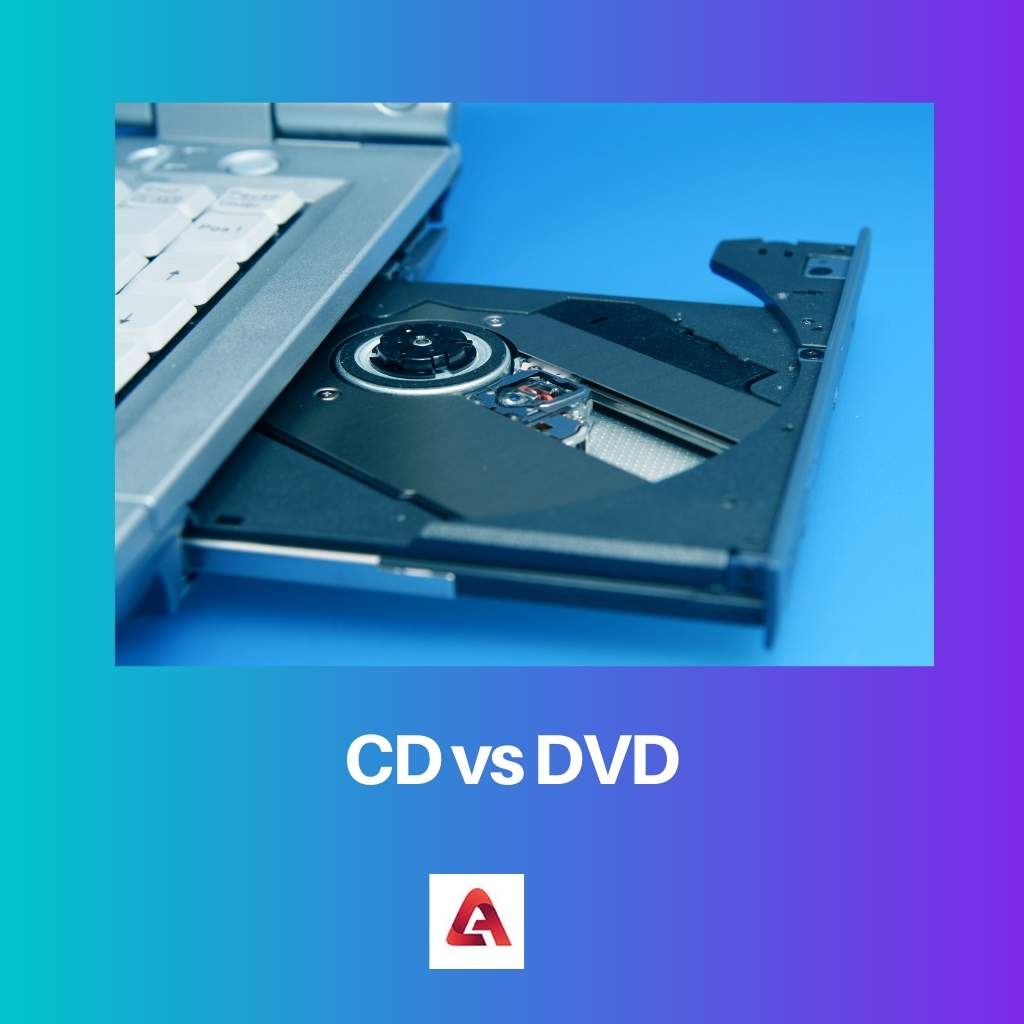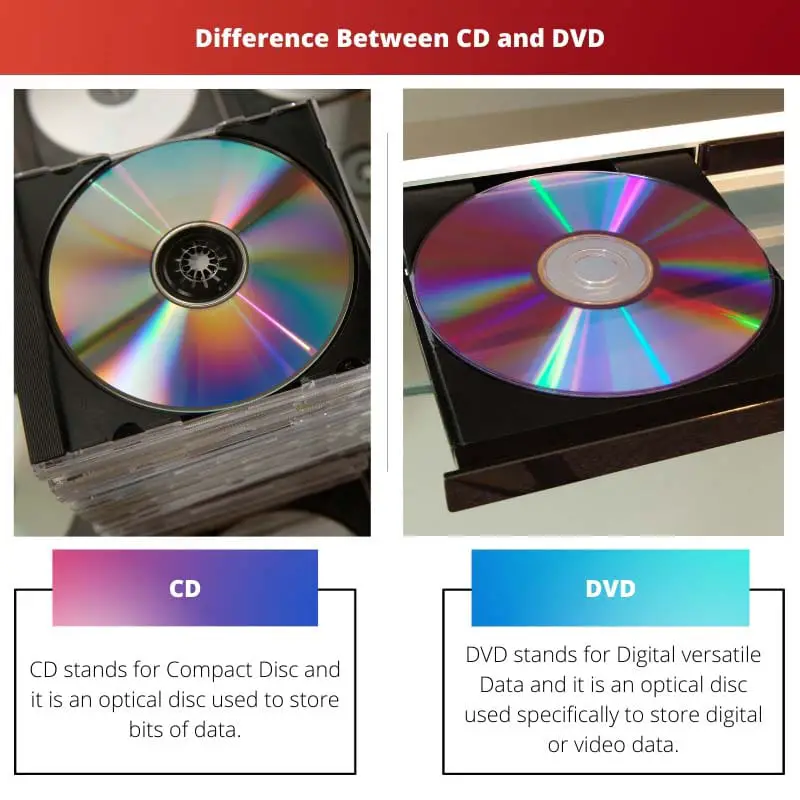Media storage in computer systems has evolved exponentially in the last couple of decades.
From floppy disks to CDs and DVDs to USBs and now SSDs and HDDs, methods of memory storage have come a long way.
Improvements in computer technology have made it possible to store large bits of data in the smallest of devices, taking a fraction of the storage space.
Key Takeaways
- CDs have a smaller storage capacity than DVDs, which can store audio and video data.
- CDs use a red laser to read data, while DVDs use a blue laser.
- CDs are used for music, while DVDs are used for movies and television shows.
CD vs DVD
CD means Compact Disc and is an optical disc that is used to store bits of data, and it has a storage capacity of 700 MB. DVD stands for Digital Versatile Disc and is focused on storing digital data without reducing the quality of the data, and it can store between 4.7 and 17 GB.

A Compact Disc (CD) is an optical disc that is used to store bits of data. The storage capacity of a normal CD is 700 MB, with each byte comprising 14 bits.
The first layer of a CD is constructed of Polycarbonate plastic, which is used to store the data. The data is stored in pits indented onto the polycarbonate surface.
Digital Versatile Disc (DVD) was invented to provide a way of storing digital data without losing the quality of the data.
Since digital data is big, there was a need for a more effective means of storage. A typical DVD can store 7 times as much data as a CD.
Comparison Table
| Parameters of Comparison | CD | DVD |
|---|---|---|
| Definition | CD stands for Compact Disc and it is an optical disc used to store bits of data | DVD stands for Digital versatile Data and it is an optical disc used specifically to store digital or video data |
| Storage capacity | CD can store 700MB of data | A typical DVD can store 4.7 to 17 GB of data |
| Storage layers | There is only one storage layer in CDs | There are two storage layers in DVDs |
| Metal layer position | The metal layer used for recording is positioned at the top | The metal layer used for recording is positioned at the middle |
| Spacing between recording pits | There are 0.834 micrometers of spacing between each pit | There is 0.4 micrometer of spacing between each pit |
What is CD?
Compact Disc (CD) is a type of optical disc used for storing bits of data. The storage capacity of a typical CD is 700MB, where one byte comprises 14 bits. CDs use laser light to retrieve data.
The data is stored in the polycarbonate layer, which is the first layer in a CD. The layer is indented with pits, which are used for storing data.
The distance between each pit is 0.834micrometer. The data is engraved in the pits using high-intensity laser light.
A thin aluminium material protects the recording layer, which is then coated with a thin layer of acrylic for more protection. There is only one reflective layer in a CD; hence, only a single layer of storage is available in a CD.
For reading the bits stored in a CD, laser light is targeted on the pits on the polycarbonate layer. The pits reflect a portion of the light, which is detected by a photodetector inside the CD player.
The detected light portion is then interpreted by the integrated circuit in the CD player and is read in the form of bits of data.
As there is only one layer of polycarbonate in a CD, the storage capacity is very limited. Hence, over the years, CDs have become obsolete.

What is DVD?
A Digital Versatile Disc (DVD) is an optical disc used specifically to store digital or video data. Since video data consists of a large byte of data, the storage capacity of DVD is also accordingly large.
The storage capacity of a typical DVD ranges from 4.7 to 17 GB. This is due to the construction of the DVD. DVD is made from the same materials as a CD but it consists of twice as many layers as a CD.
In a DVD, the data is stored in a polycarbonate layer. In a CD, there is only one layer of polycarbonate. Hence, the storage capacity of a CD is very limited.
On the other hand, in a DVD, there are two polycarbonate layers. Since there are two reflective layers in a DVD, there is twice as much storage space available in a DVD.
The bits of data are engraved onto pits indented on the polycarbonate surface of the DVD.
In a DVD, the pits are more closely spaced. The distance between two consecutive pits on a DVD is 0.4 micrometres.
As there is dense packing of pits on a DVD, more bits can be stored, increasing the storage capacity of the DVD. Hence, a DVD is a more efficient and effective method of storing digital data than a CD.

Main Differences Between CD and DVD
- CD stands for Compact Disc. It is a type of optical disc used for storing bits of data. DVD stands for Digitally Versatile Disc, and it is an optical storage media used specifically for storing digital or video data.
- The storage capacity of a CD is 700MB. The storage capacity of DVDs ranges from 4.7GB to 17 GB.
- There is only one layer of polycarbonate in a CD. There are two polycarbonate layers in a DVD.
- In a CD, the metal layer used for recording is located at the top. In a DVD, the metal layer used for recording is located in the middle of the disc
- The spacing between each pit used for recording data in a CD is 0.834 micrometres. The pit spacing in a DVD is 0.4 micrometers.

- https://www.aes.org/e-lib/online/browse.cfm?elib=12144
- https://www.google.com/books?hl=en&lr=&id=BGnxDwAAQBAJ&oi=fnd&pg=PR9&dq=compact+disc&ots=36ebh0vDhz&sig=MK0tsVuMoSNZYf9C_xlZQe4eBFE
- https://ieeexplore.ieee.org/abstract/document/7243464/
- https://iopscience.iop.org/article/10.1143/JJAP.37.2257/meta